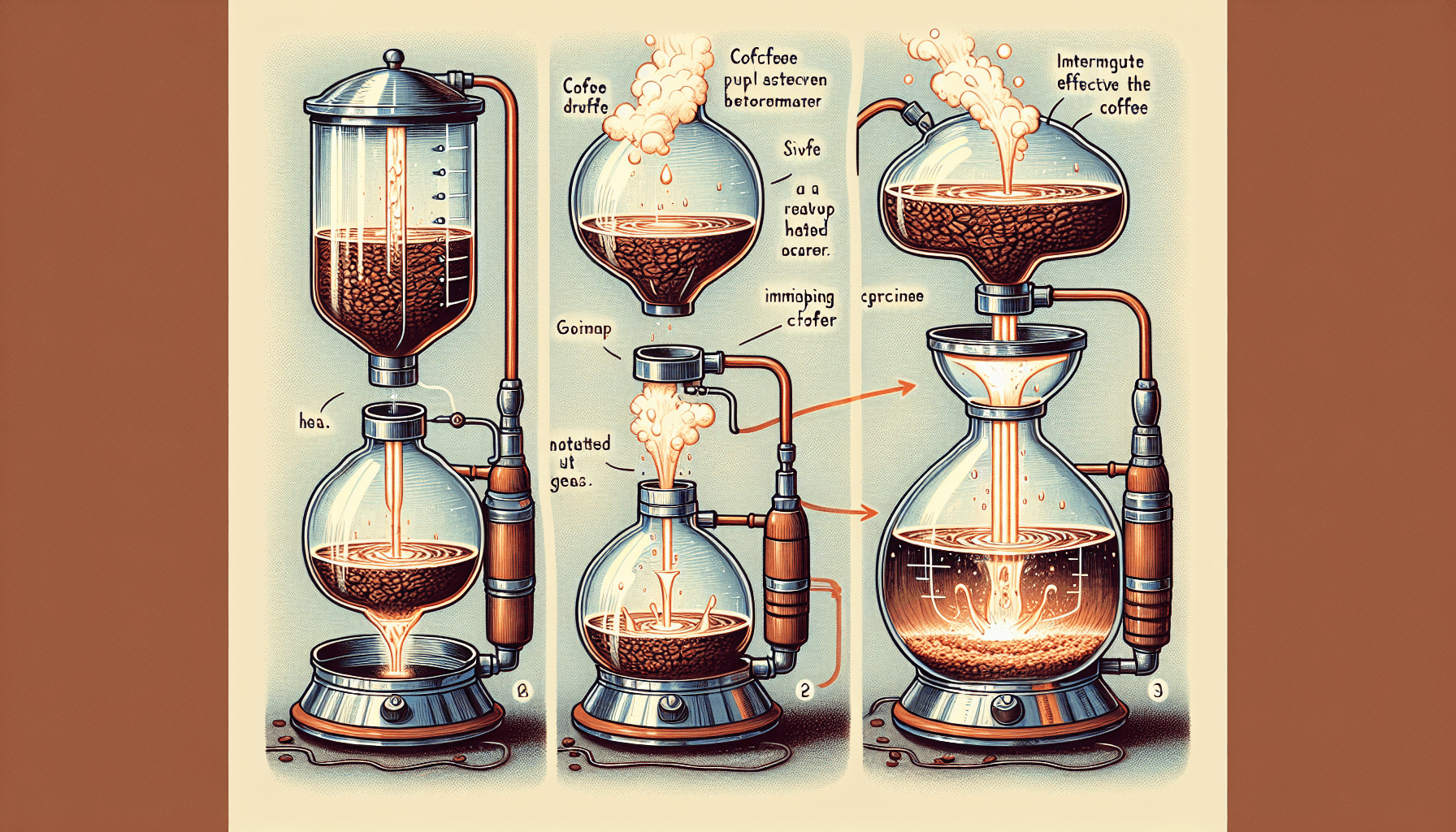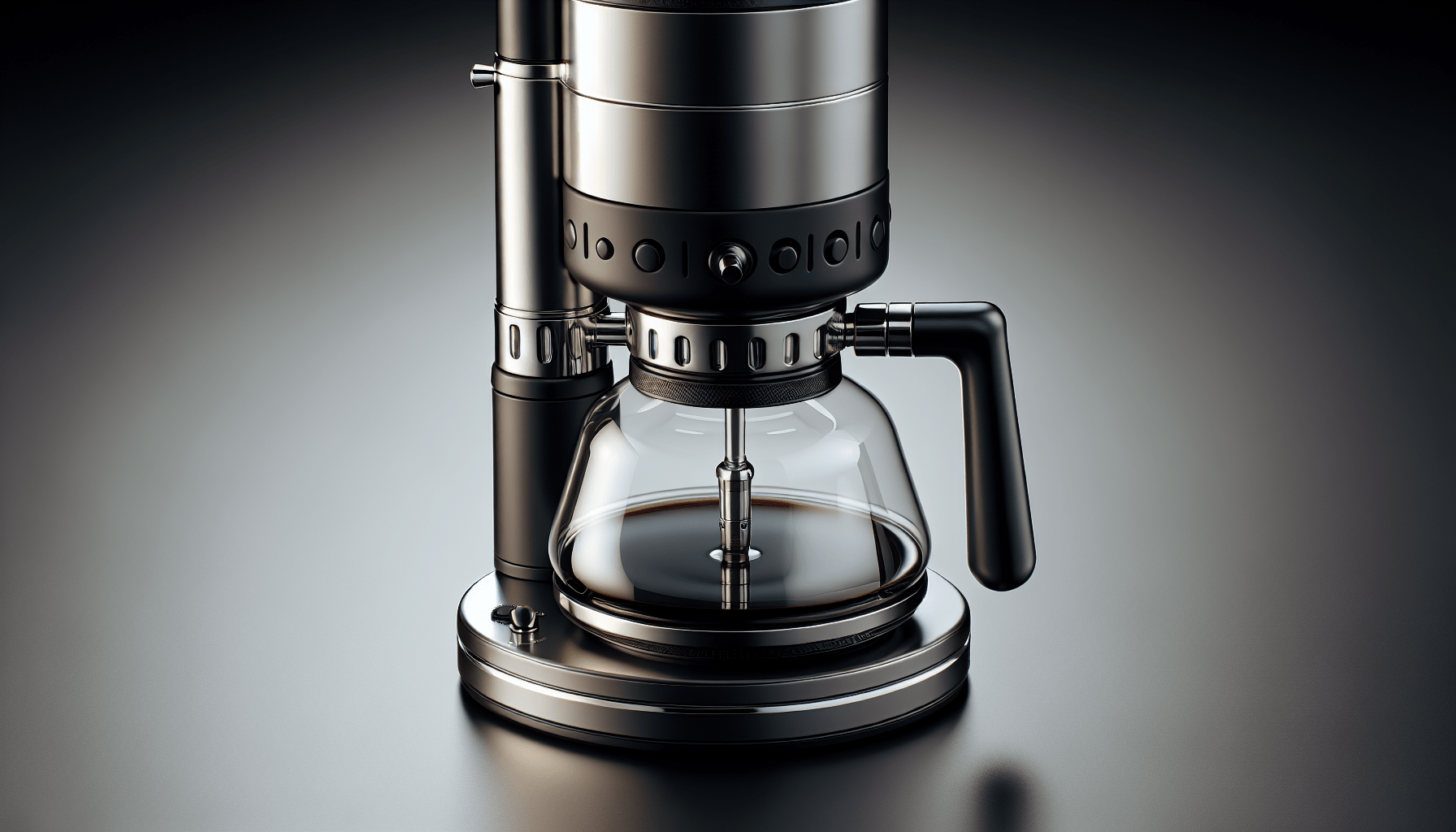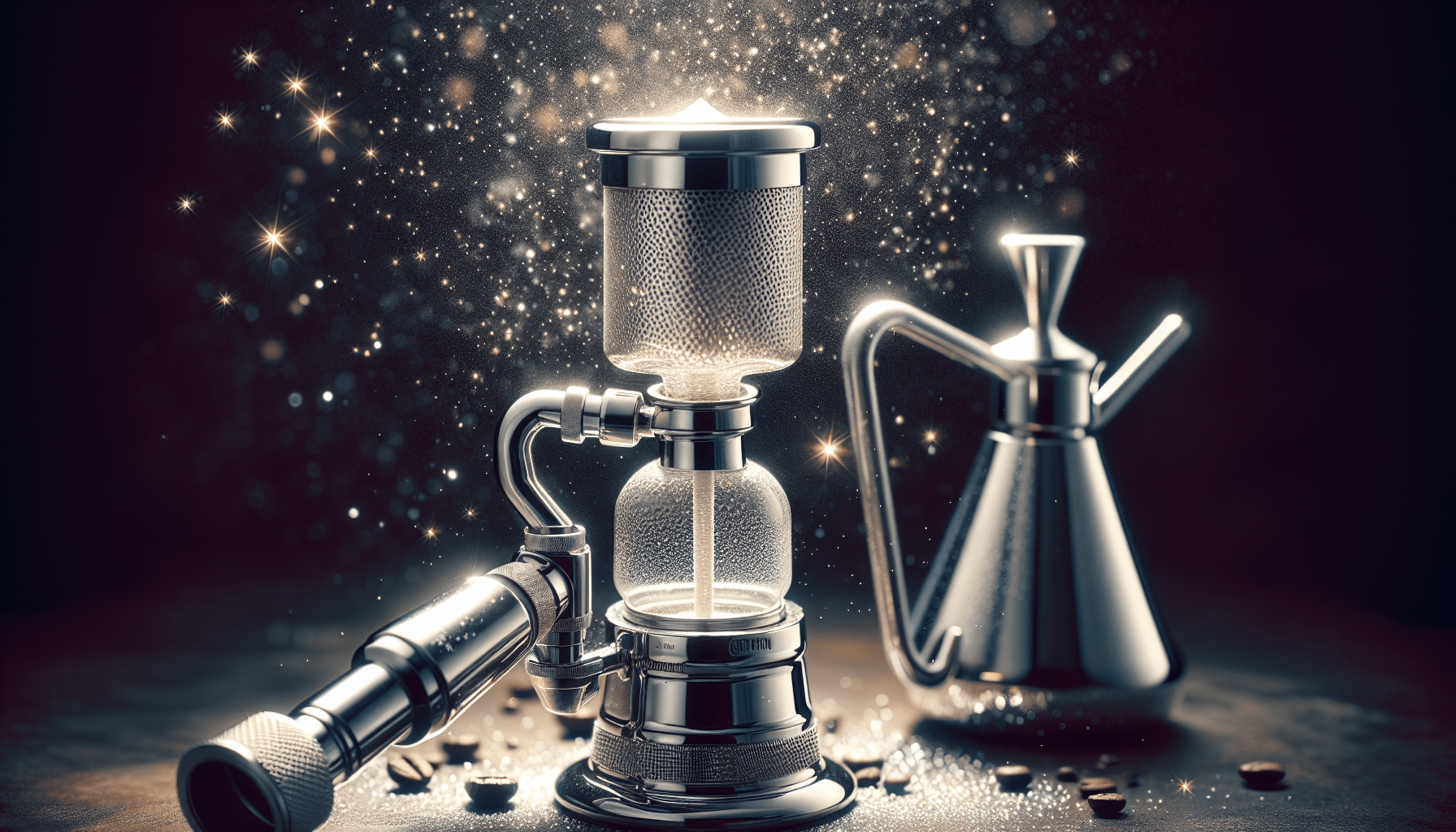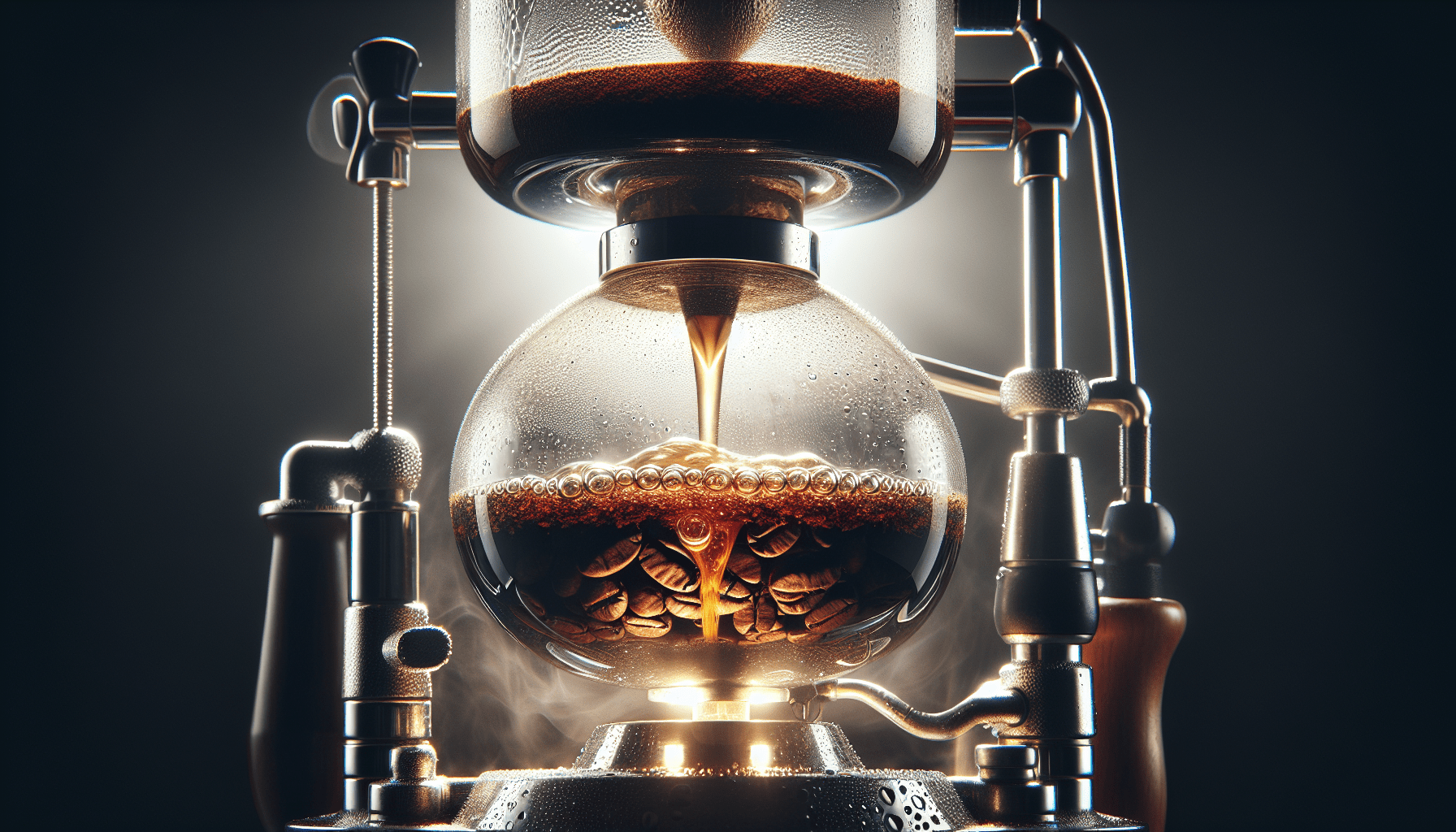Have you ever wondered what the perfect water-to-coffee ratio is for brewing with a siphon coffee maker? Well, look no further, because in this article, we will uncover the secrets of achieving the ideal balance for the best possible cup of coffee. Whether you’re a coffee aficionado or just enjoy a good cup of joe, understanding the importance of the water-to-coffee ratio will take your brewing skills to the next level. So grab a cup of your favorite brew and get ready to learn all about this fascinating topic!
Understanding the siphon coffee maker
What is a siphon coffee maker?
A siphon coffee maker, also known as a vacuum coffee maker, is a unique and fascinating brewing device that creates a smooth and clean cup of coffee. It consists of two chambers, one on top and one at the bottom, which are connected by a tube. The bottom chamber holds water, while the top chamber houses the ground coffee. The heat source creates a pressure difference, causing the brewed coffee to rise into the top chamber and then filtered back into the bottom chamber when the heat is removed.
How does it work?
The siphon coffee maker operates on the principles of vapor pressure and vacuum. As heat is applied to the bottom chamber, the water is vaporized, creating pressure that forces the water upward through the tube and into the top chamber. The coffee grounds are then introduced to the water, allowing for the extraction process to take place. Once the heat is removed, the vapor pressure decreases, causing a vacuum effect that pulls the brewed coffee back down into the bottom chamber, leaving the grounds behind in the top chamber.
Why is it popular?
The siphon coffee maker has gained popularity among coffee enthusiasts due to its elegant design and ability to produce a clean and flavorful cup of coffee. The brewing process is unique and visually appealing, captivating anyone who witnesses it. Additionally, the siphon brew method allows for optimal extraction, as the coffee grounds are fully saturated and evenly steeped. This results in a smooth and aromatic coffee experience that showcases the delicate flavors of the beans.
The importance of water-to-coffee ratio
Why is the ratio important?
The water-to-coffee ratio is a crucial element in brewing coffee with a siphon coffee maker. It determines the strength, body, and overall taste of the final cup. The right ratio ensures that the coffee grounds are adequately extracted, striking a balance between under-extraction and over-extraction. Finding the ideal ratio is essential for achieving the desired flavor profile and avoiding any bitterness or unpleasantness in the coffee.
How does it affect the taste?
The water-to-coffee ratio directly affects the taste of the brewed coffee. A higher ratio, meaning more water in proportion to coffee, will result in a milder and less concentrated brew. On the other hand, a lower ratio, with less water relative to coffee, will yield a stronger and bolder cup. By adjusting the ratio, you have the power to craft a coffee that suits your personal preferences, whether you prefer a robust and intense flavor or a more nuanced and delicate taste.
Achieving balance
Achieving the perfect water-to-coffee ratio is about finding the right balance to highlight the desirable characteristics of the beans without overpowering or diluting them. It’s important to experiment with different ratios to discover the sweet spot that brings out the flavors you enjoy the most. Additionally, factors such as the type of coffee beans, grind size, and brewing time also impact the overall taste, so it’s important to consider these elements in conjunction with the water-to-coffee ratio to achieve a well-rounded and balanced cup of coffee.
Factors to consider
Type of coffee beans
The type of coffee beans you choose plays a significant role in determining the ideal water-to-coffee ratio. Different beans have varying levels of density, oiliness, and flavor profiles. For example, lighter and more delicate beans may require a higher water-to-coffee ratio to fully extract their subtle flavors, while darker and more robust beans may benefit from a lower ratio to avoid overpowering the cup with bitterness. It’s important to consider the characteristics of your chosen beans and adapt the ratio accordingly.
Grind size
The grind size of coffee beans also impacts the extraction process and, therefore, the water-to-coffee ratio. A finer grind exposes more surface area of the coffee, allowing for faster extraction and may require a slightly lower ratio to prevent over-extraction. Conversely, a coarser grind necessitates a higher ratio as the water needs more contact time to fully extract the flavors. The key is to find the balance where the grind size and water-to-coffee ratio work in tandem to produce a well-extracted and balanced cup of coffee.
Brewing time
The brewing time is another factor that influences the water-to-coffee ratio. Longer brewing times may require a higher ratio to account for the extended contact time between the water and coffee grounds, preventing the brew from becoming too strong or bitter. Conversely, shorter brewing times may necessitate a lower ratio, ensuring that the coffee is not under-extracted and lacks flavor. It’s important to consider the desired brewing time when determining the appropriate water-to-coffee ratio for your siphon coffee maker.
Personal preference
Ultimately, personal preference is a crucial factor to consider when determining the water-to-coffee ratio for your siphon coffee maker. Everyone’s taste buds are unique, and what may be perfect for one person may not be suitable for another. Experimentation and exploration are key to finding the ideal ratio that aligns with your preferences. Don’t be afraid to adjust and fine-tune the ratio until you achieve a cup of coffee that brings you joy and satisfaction.
Recommended water-to-coffee ratios
Standard ratio
A common starting point for a water-to-coffee ratio with a siphon coffee maker is 1:15, meaning one part coffee for every 15 parts of water. This ratio typically produces a well-rounded and balanced cup of coffee with medium strength and flavor intensity. It serves as a great baseline to get acquainted with the brewing process of the siphon coffee maker and can be adjusted according to personal taste preferences.
Stronger brew ratio
If you prefer a stronger and bolder cup of coffee, you can consider increasing the coffee-to-water ratio. Experiment with ratios such as 1:12 or even 1:10, allowing for a higher concentration of coffee in the final cup. This adjustment will result in a more intense flavor and a robust body, perfect for those who crave a powerful coffee experience.
Weaker brew ratio
Conversely, if you enjoy a milder and more delicate brew, you can decrease the coffee-to-water ratio. Try ratios like 1:18 or 1:20 to achieve a lighter flavor and a smoother mouthfeel. This ratio highlights the subtle nuances of the coffee beans, allowing for a more nuanced and nuanced sip.
Tips for finding the right ratio
Experiment with different ratios
Discovering the ideal water-to-coffee ratio for your siphon coffee maker is an enjoyable journey of experimentation. Start by using the standard ratio as a baseline and gradually adjust it up or down to explore different flavor profiles. Keep a record of the ratios you try and the corresponding taste notes to track your progress and findings.
Note the taste and strength
When experimenting with different ratios, pay close attention to the taste and strength of the brewed coffee. Take note of any changes you observe, such as enhanced flavors, increased bitterness, or a weaker taste. Understanding these variations will help you pinpoint the water-to-coffee ratio that aligns with your preference.
Adjust based on personal preference
Remember that the water-to-coffee ratio is a personal choice, and there is no one-size-fits-all solution. Take into account your desired flavor profile and adjust the ratio accordingly. Whether you prefer a stronger or weaker brew, continue to fine-tune the ratio until you find the perfect balance that caters to your unique taste preferences.
Calculating the right amount of water and coffee
Determining coffee weight
To calculate the coffee weight, you can use a scale to measure the desired amount of coffee. Start with the chosen water-to-coffee ratio and determine the weight of the coffee based on the amount of brewed coffee you wish to make. For example, if you aim to brew 300 grams of coffee with a 1:15 ratio, divide 300 by 15 to determine that you will need 20 grams of coffee.
Calculating water volume
To calculate the water volume, you can use measuring cups or other volume measurement tools. Multiply the weight of the coffee by the ratio to determine the amount of water needed. If you have 20 grams of coffee and you’re using a 1:15 ratio, multiply 20 by 15 to find that you will need 300 milliliters of water.
Methods for measuring water and coffee
Using a scale
Using a scale to measure both the coffee and water is the most accurate method for achieving the desired water-to-coffee ratio. Place the carafe or container on the scale, reset it to zero, and measure the appropriate amount of coffee beans. Then, reset the scale to zero again, pour in the water slowly, and measure the desired amount. This method ensures precision and consistency in your brewing process.
Using measuring cups or spoons
If you don’t have a scale available, you can use standard measuring cups or spoons to estimate the amount of coffee and water. However, keep in mind that this method may not provide the same level of accuracy as using a scale. Follow the markings on the cups or spoons to measure the desired amounts, taking care to level off the coffee and avoid excessive packing or scooping to maintain consistency.
Techniques for achieving a balanced extraction
Preheating the siphon
One technique to achieve a balanced extraction with a siphon coffee maker is preheating the device. Fill the bottom chamber of the siphon with hot water before starting the brewing process. This will ensure that the water remains at a stable temperature throughout the brewing, preventing any fluctuations that may affect the extraction.
Controlling the brewing time
Controlling the brewing time is crucial for achieving a balanced extraction. Follow the manufacturer’s recommended brewing time for your particular siphon coffee maker. If the coffee is brewing too quickly or too slowly, adjust the heat source accordingly. Aim for a consistently timed extraction to ensure that the flavors are properly extracted without any excessive bitterness.
Stirring during brewing
During the brewing process, gently stir the coffee grounds in the top chamber to ensure even saturation and extraction. Use a wooden or plastic spoon to agitate the coffee grounds, allowing for a more consistent and balanced extraction. This technique helps distribute the water evenly and promotes optimal extraction, resulting in a well-rounded and flavorful cup of coffee.
Common mistakes to avoid
Using too much or too little coffee
Using an incorrect amount of coffee can lead to an imbalanced flavor profile. Using too much coffee relative to the water will result in an intense and overpowering brew, while too little coffee may result in a weak and flat-tasting cup. It’s important to carefully measure the amount of coffee and maintain the desired water-to-coffee ratio to prevent these extremes.
Using incorrect grind size
The grind size of the coffee beans significantly affects the extraction process. Using a grind that is too coarse may lead to under-extraction, resulting in a weak and watery cup. Conversely, using a grind that is too fine can lead to over-extraction, causing the coffee to become bitter and unpleasant. It’s crucial to match the grind size with the brewing method and adjust as necessary for a balanced extraction.
Neglecting brewing time
Neglecting the brewing time can have a direct impact on the coffee’s flavor profile. Over-brewing can result in a bitter and over-extracted cup, while under-brewing may lead to a weak and underwhelming taste. Follow the recommended brewing time for your specific siphon coffee maker and make adjustments based on taste preferences and experimentation.
Neglecting temperature control
Temperature control is vital in achieving a balanced extraction. If the water is too hot, it can lead to over-extraction and a burnt taste. Conversely, if the water is not hot enough, the coffee may be under-extracted and lack flavor. Maintain the appropriate temperature throughout the brewing process to ensure optimal extraction and a flavorful cup of coffee.
Conclusion
The ideal water-to-coffee ratio for brewing with a siphon coffee maker ultimately depends on personal preference and the desired flavor profile. Experimentation and exploration are key to discovering the perfect ratio that suits your taste buds. Consider factors such as the type of coffee beans, grind size, and brewing time when determining the ratio and be prepared to make adjustments based on your findings. By finding the right balance, you can enjoy a delicious and satisfying cup of coffee consistently. Remember, the journey to the perfect ratio is part of the joy of brewing with a siphon coffee maker, so have fun and happy brewing!




